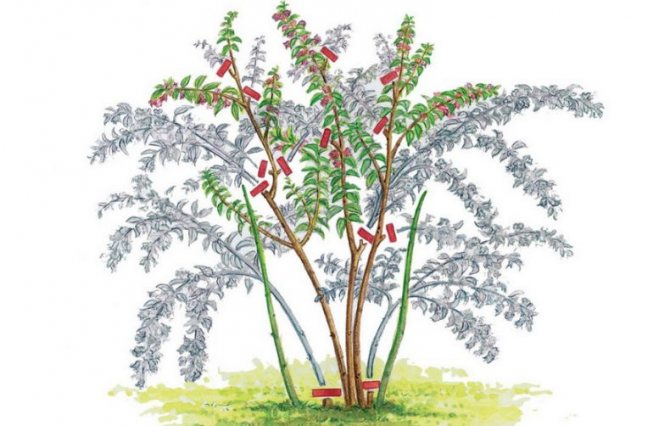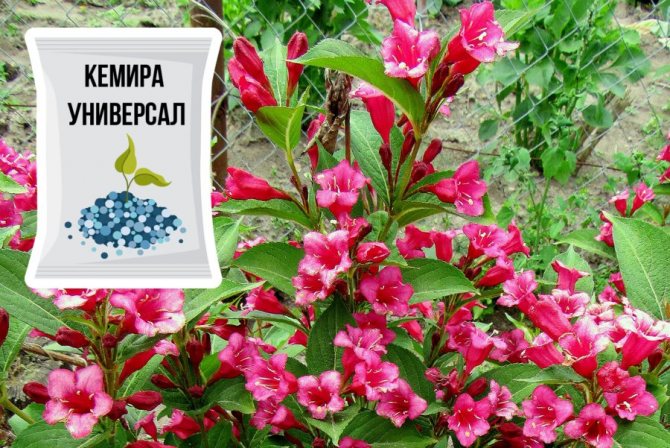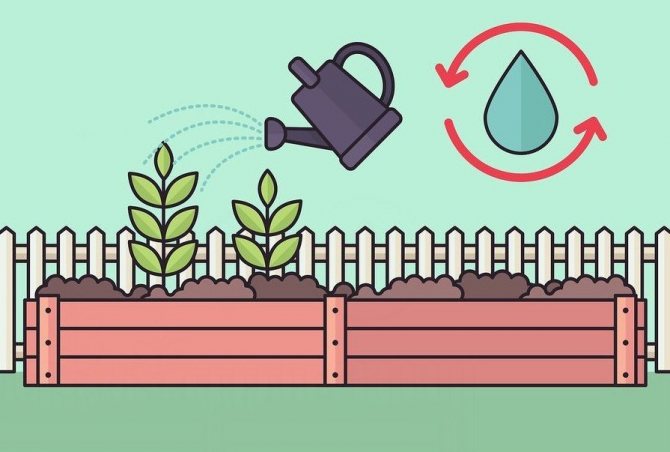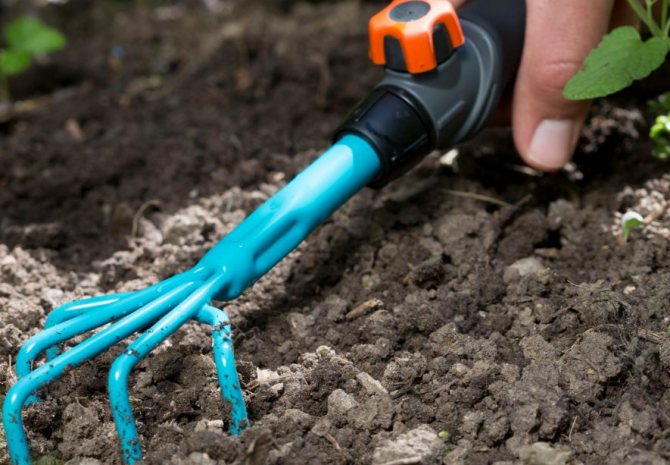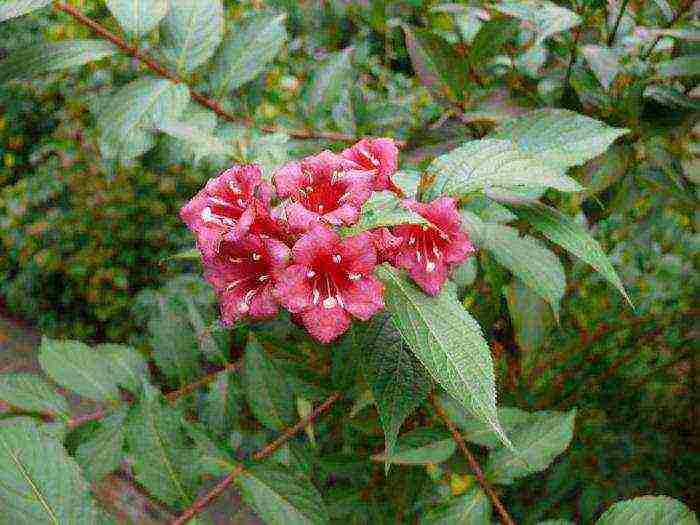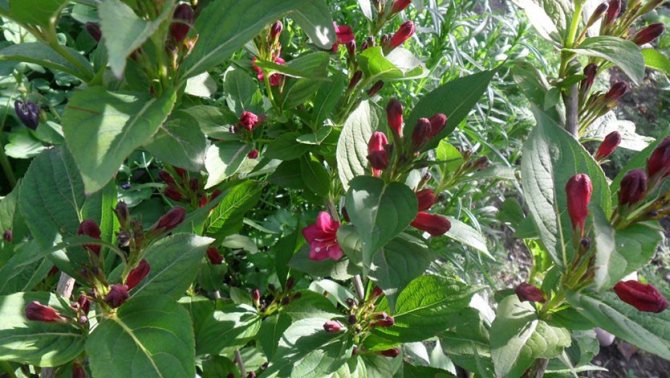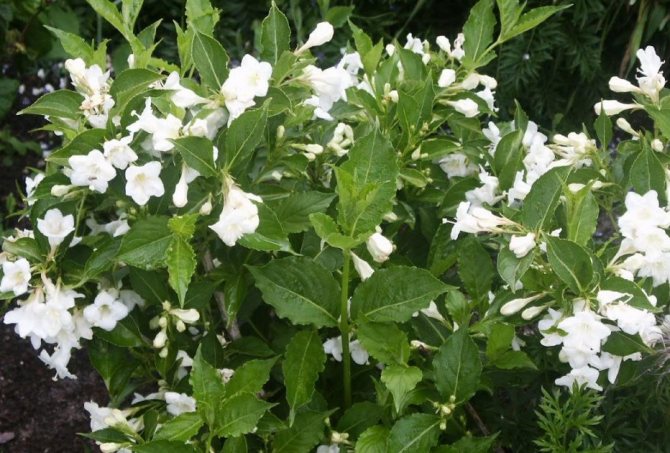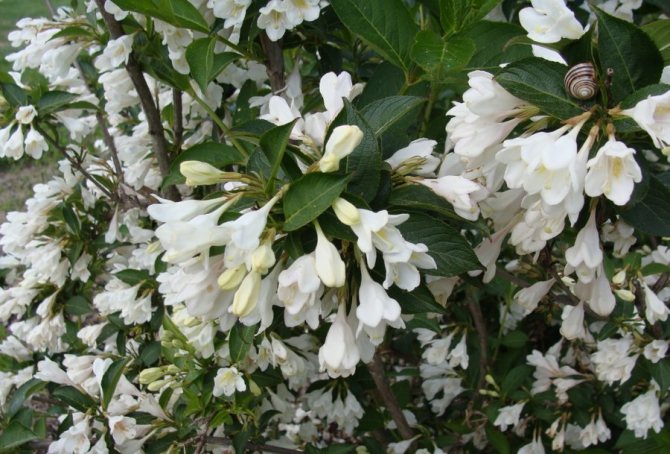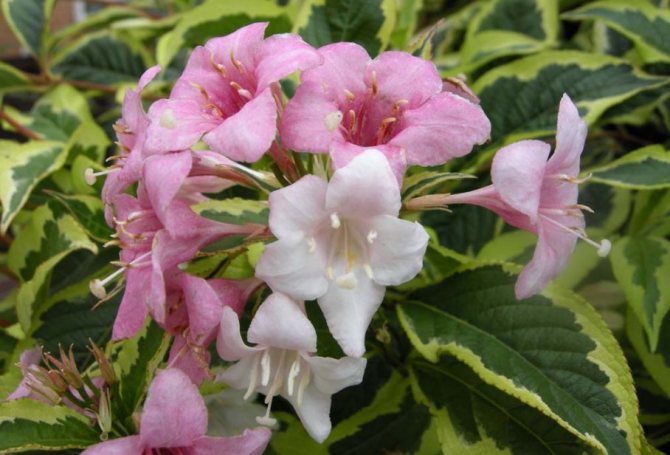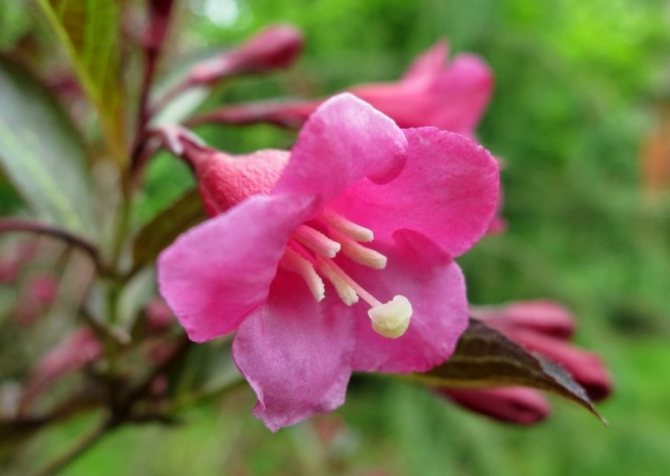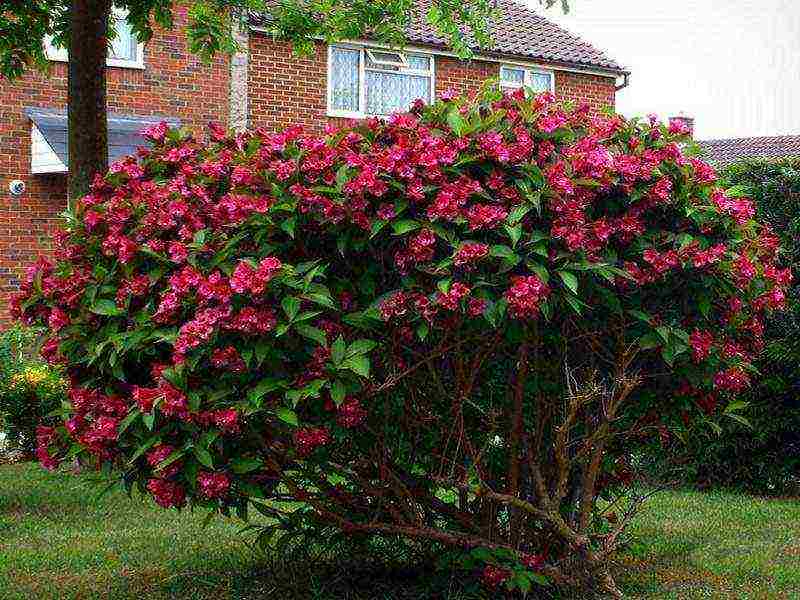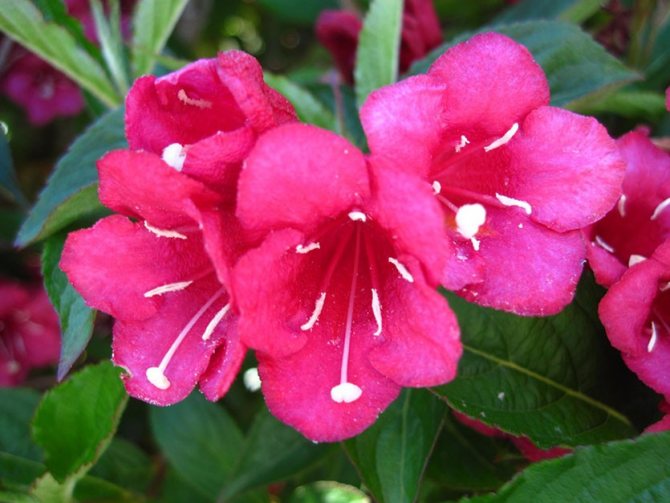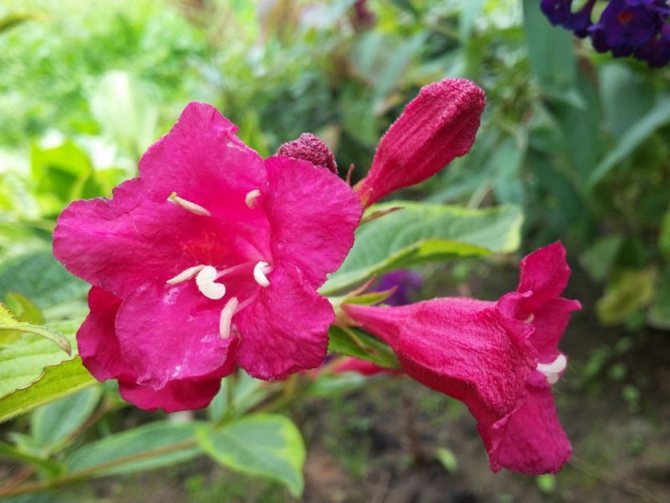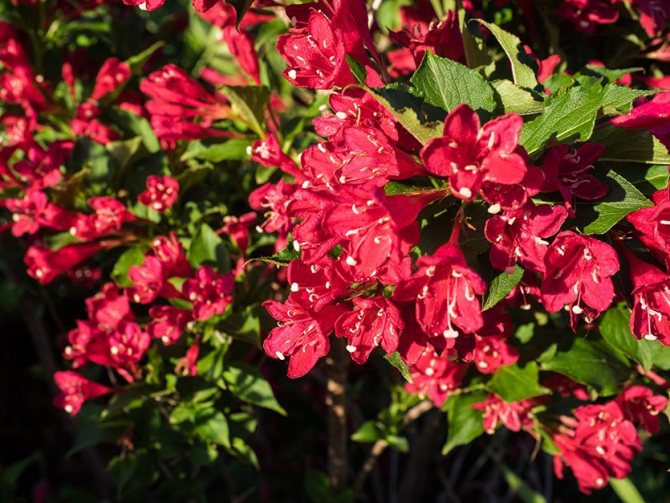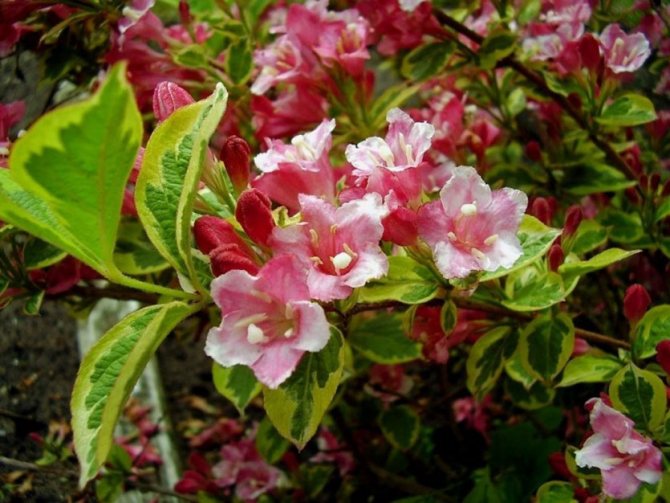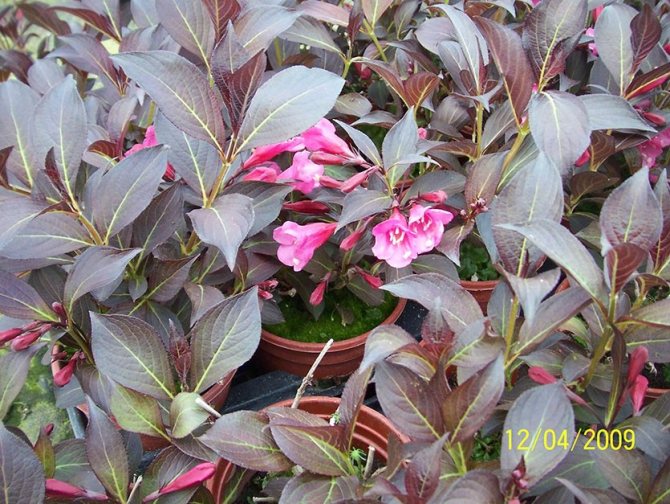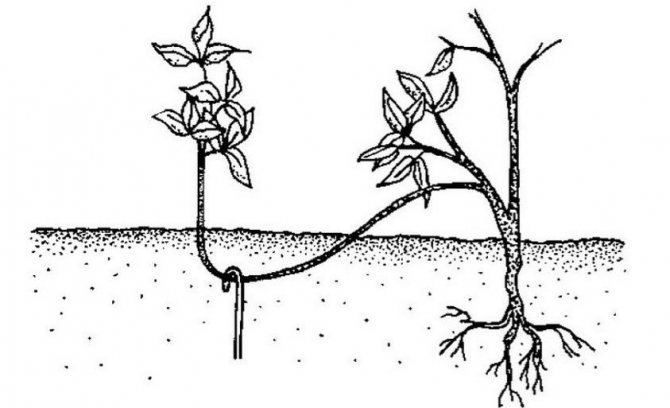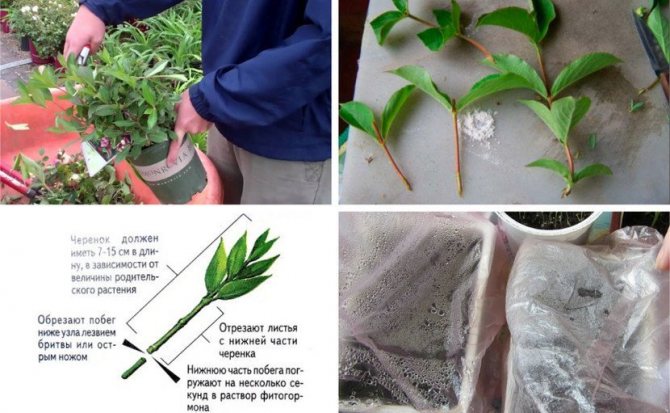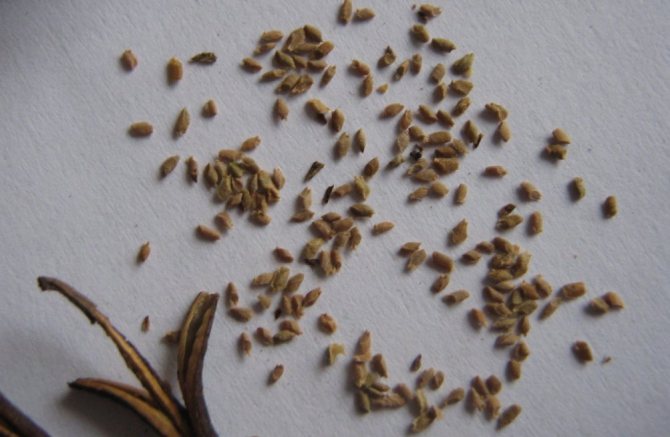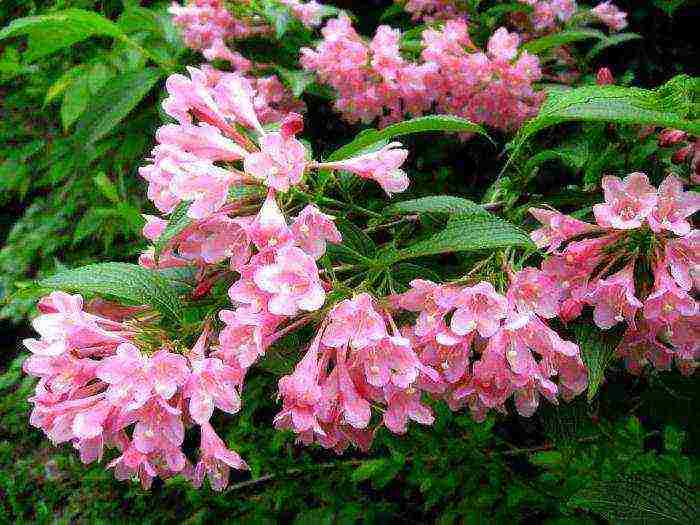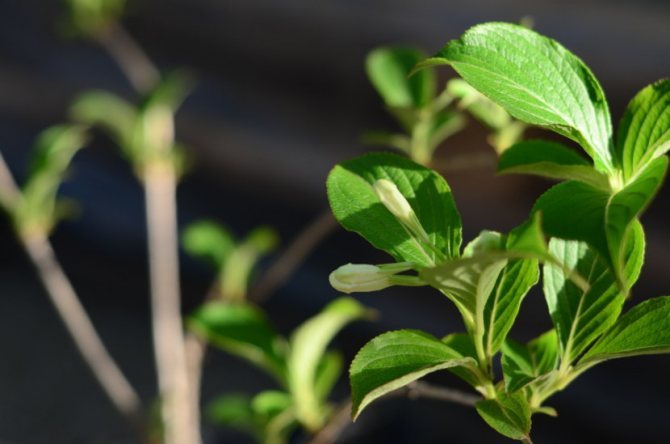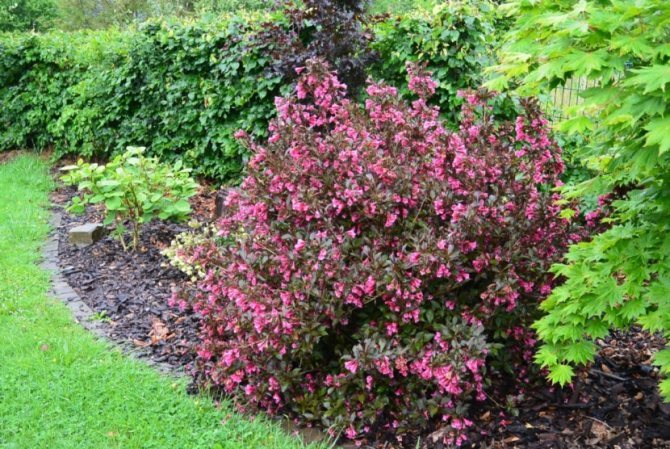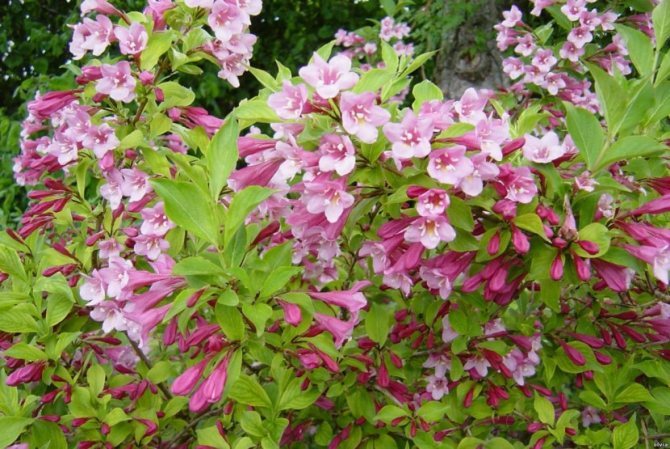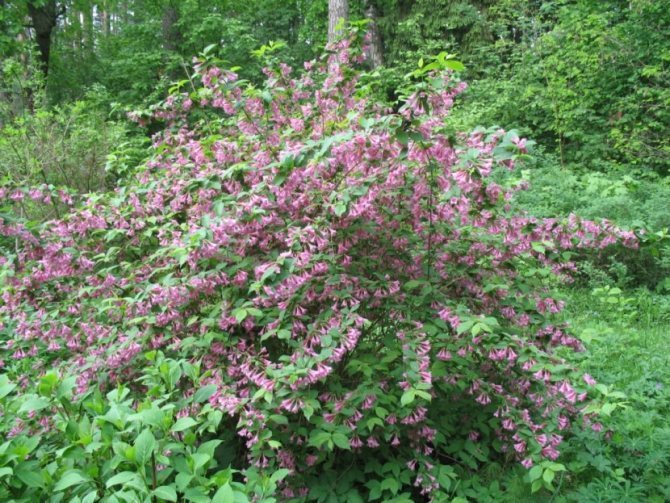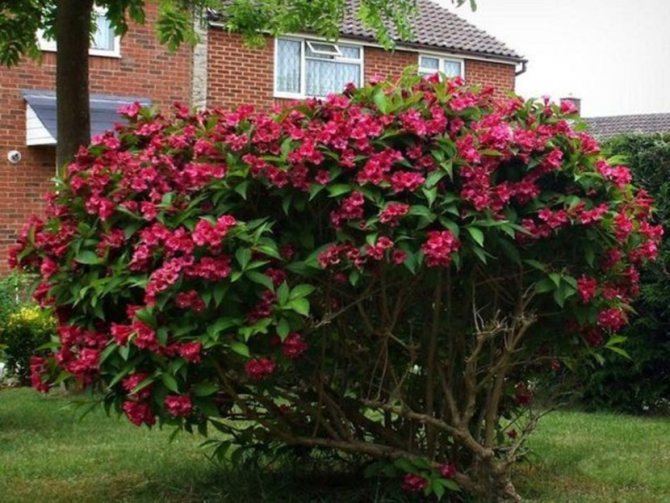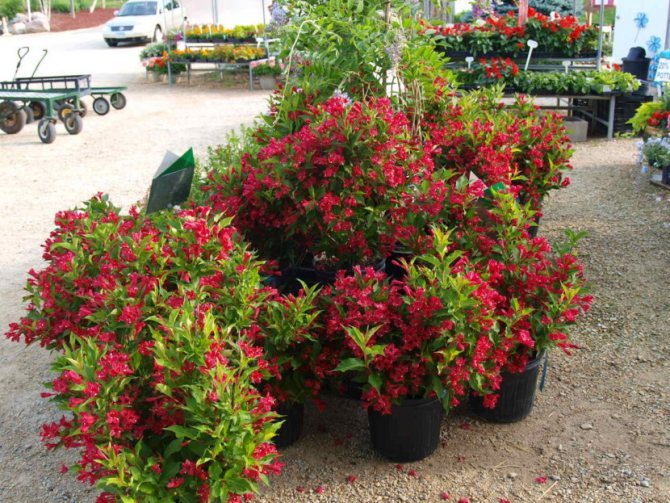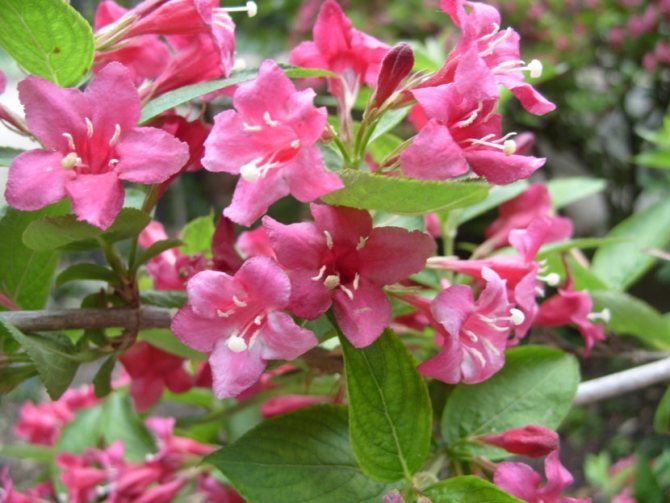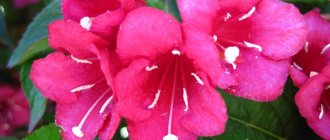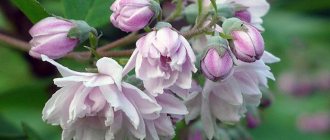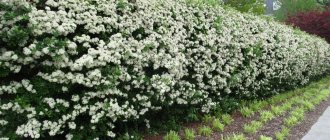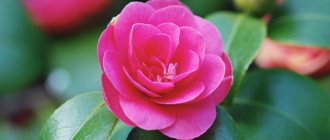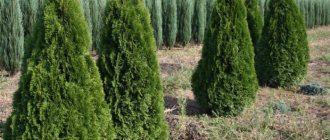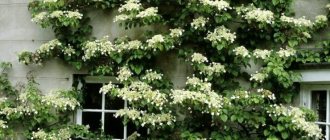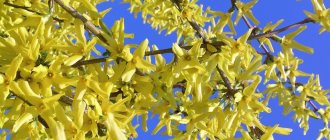Weigela: planting and care in the open field, photo and description of the shrub, varieties and types
Weigela is listed in the genus of deciduous flowering shrubs. This shrub came to Europe from the Far East
.
The content of the article:
1. Weigela: a description of the plant 2. Planting a weigela shrub 3. Caring for a shrub 4. How to fertilize correctly 5. Pruning weigela 6. Types and varieties of weigela 6.1 Weigela Middendorf 6.2 Weigela flowering 6.3 Type of weigela hybrid 6.4 Veigela early 6.5 Weigela Korean 6.6 Type of weigela Japanese 6.7 Weigela pleasant 6.8 Weigela Maksimovich 7. Weigela propagation methods 7.1 Seed propagation 7.2 Propagation by cuttings 8. Weigela in landscape design 9. Diseases and pests
Weigela: description of the plant
The shrub owes its name to the German botanist and chemist von Wegel, who lived in the years 1748-1831 of the 19th century. Having appeared in European countries, weigela won the hearts of gardeners. They worked hard to acquire this beautiful shrub.
Description of weigela - video
Weigela is directly related to the Honeysuckle family. The stems of the shrub are erect, gradually lignified. The root system does not cover the immediate area. Branching occurs from the base of the root collar.
Weigela photos
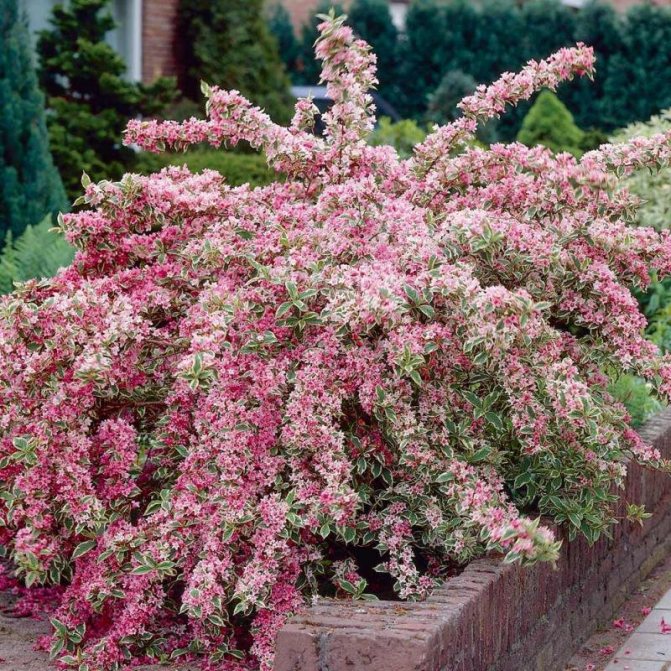
Weigela is attracted by the fact that it can bloom twice in one season.
The first time the shrub blooms in mid-May and continues to delight for 1 month. The second flowering occurs at the end of August, but the number of inflorescences will be less than the first time.
Weigela flowers are a separate topic. They are beautiful in structure and color. They can be painted in creamy pink, cream, raspberry or yellow. Moreover, the color of the inflorescences can change. A pale flower tone is hidden in the bud, but as it unfolds, it becomes saturated and bright.
Garden forms
- Bright red weigela Bristol Ruby will make any garden area bright and attractive. Its flowers resemble bells in shape, they form beautiful inflorescences of 4-5 pieces. Their diameter reaches 5 centimeters. The combination of rich red flowers and vibrant greenery will not leave anyone indifferent. This type of plant is resistant to frost. Weigela, unpretentious to soils (reproduction will not be difficult), will be a decoration of the garden. The place for Bristol Ruby can be found both in the shade and in the sun. The main flowering period is early summer (the first two months). This plant can please with repeated flowering. However, like all other species, the Bristol Ruby weigela does this a second time less abundantly, and its flowers are concentrated on the tops. Every year the shrub grows both in height and in width (by 20-30 centimeters). Weigel Bristol Ruby will delight the eye for an average of 50 years. The size of an adult shrub reaches three meters in height. The formed crown has a diameter of 3.5 meters.
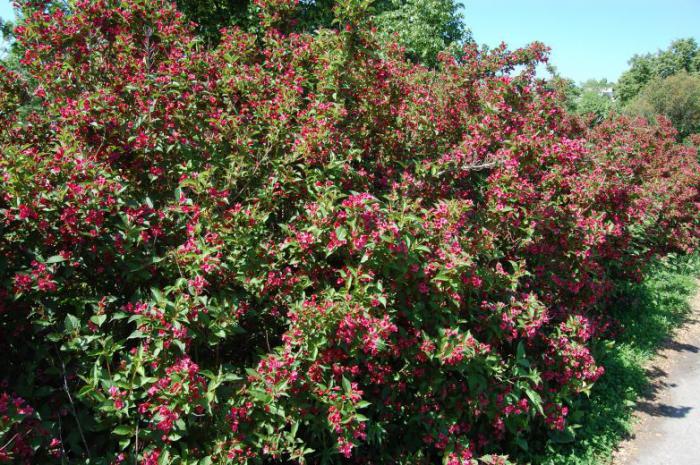

- Weigela Gustave Mallet. The buds of a marvelous pink color with a white border will attract the attention of even those passers-by who do not consider themselves to be flower growers. This variety of weigela will please the eye during the period from late May to early June (15-20 days). The flower reaches five centimeters in diameter, and the height of an adult shrub is two and a half meters.
- Weigela Eva Rathke. This variety was developed in Poland.Unlike many others, he is short. Plant height reaches only one meter. The red flower changes its hue from more intense on the outside to delicate on the inside. This gives it a special charm. The leaves, which vary in length from 6 to 10 centimeters, are elliptical. The highlight of Eva Rathke (the plant will delight with flowering in late July and early August) are the brilliant flowers. This variety does not belong to frost-resistant varieties, so it is better for him to spend the winter under cover. Weigela Eva Rathke grows quite quickly, and the diameter of the crown of an adult shrub can reach three meters.
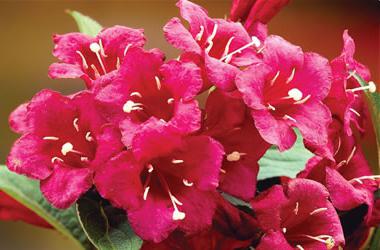

- Weigela Rosea. Frost-resistant undersized weigela Rosea will dilute autumn colors with scarlet. This is the color of the leaves of this shrub in the fall. She will also surprise with unusually large pale pink flowers with streaks of white. This variety is unpretentious, has a spreading crown and will add a touch of piquancy to your garden area.
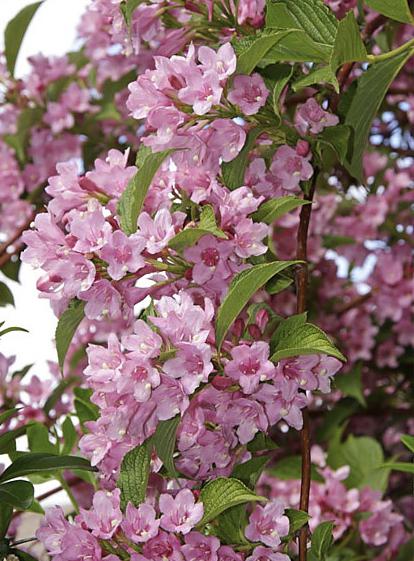

- Weigela Candida. Weigela, which has a gorgeous crown reaching 3.5 meters in diameter, and white flowers up to 4 centimeters long. The flowering period is late spring and early summer. This variety is picky about the soil. He prefers fertile land and does not tolerate stagnant water. The height of Candida weigela reaches two meters, and every year its branches lengthen by an average of 25 centimeters. With proper care, the shrub will delight the eye for fifty years.
- Weigela Styriaca. This variety is distinguished by light leaves and small flowers. The diameter of the latter reaches 2–2.5 cm in length. The color of the buds is red, reminiscent of strawberries. This is the highlight of this variety. In addition, cut buds will last longer than other Weigela varieties. The flowering period is late May - early June. It averages 2–2.5 weeks. When the shrub finishes blooming, the buds change color from red to carmine. The difference between this type of weigela is the openwork crown, the diameter of which reaches three meters. The shrub grows at an impressive pace. The height of an adult plant is 2.5 meters. Weigela needs to be covered for the winter.
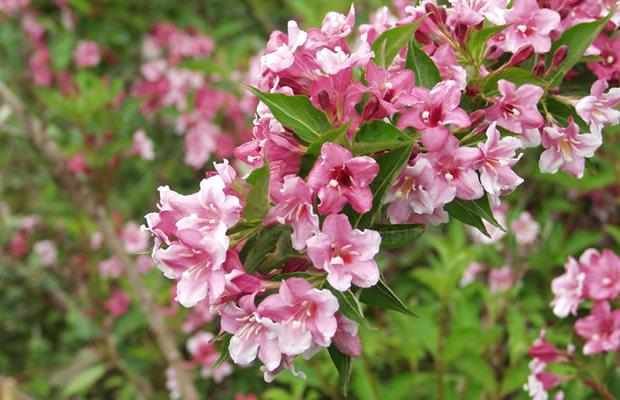

Planting a weigela bush
A beautifully flowering shrub prefers a sunny area with partial shade. Delicate inflorescences need careful care, so areas prone to drafts are not suitable for weigela. It is worth starting planting in the spring after warming up the soil. Seedlings are selected at 3 years of age.
A distance of 150-200 cm should be maintained between adjacent bushes. The volumes of the planting pit should be suitable for the size of the root system of the seedling.
Planting and caring for weigela - video
At the bottom of the pit, rubble or broken brick is placed for drainage. The roots should be carefully straightened and sprinkled with soil to the level of the root collar. It has been noticed that the autumn planting of the shrub may end in failure. For those who have purchased a seedling, it is recommended to dig it in at an angle for the winter, partially covering the crown with soil, and to make a full planting of the weigel in the spring.
![Tinkoff (Debit Card) [CPS] RU](https://bgn.imadeself.com/wp-content/uploads/tinkoff-debetovaya-karta-cps-ru2.jpg)
![Tinkoff (Debit Card) [CPS] RU](https://bgn.imadeself.com/wp-content/uploads/tinkoff-debetovaya-karta-cps-ru2.jpg)
Features of growing in the suburbs
Not all types of shrubs are suitable for our difficult climate. Even the most unpretentious species of weigela can freeze slightly in winter without shelter. To enjoy lush flowering, you need to responsibly choose the variety and place to place the shrub.
Weigela prefers sunny places, although it grows well in the shade, but then its flowering is not so lush. You need to choose secluded corners of the garden, closed from cold winds. Better to place near buildings on the south or east side. Often the shrub is planted as part of hedges, along with barberry, spirea, juniper. Low-growing varieties thrive on alpine slides.
The soil needs to be loose, with a high humus content and good drainage.Optimal composition: a mixture of humus, garden soil and sand (1: 2: 2). Heavy, overly wet soils are not suitable.
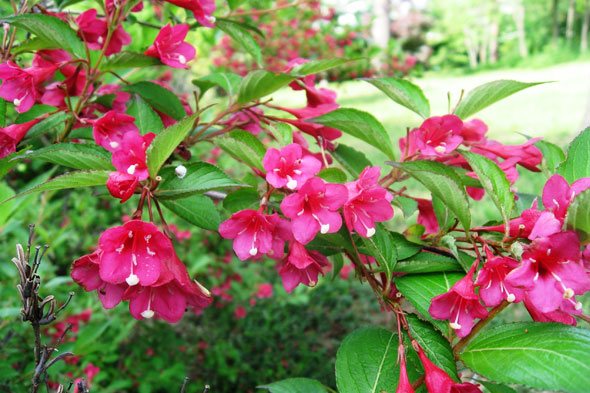

If weigela seedlings are purchased in a store, their age should be clarified. The best specimens take root at the age of 3 - 4 years. As a rule, they are sold with a closed root system, but if the bush has just been dug out in the nursery, the roots must be examined - they should not have growths and seals. A healthy root system of weigela is fibrous, with a large number of small thin roots.
Weigela: bush care
Shrub with beautiful inflorescences will respond positively to fertile soil, loose soil and its constituent humus and leafy soil.
The main mistake of caring for this shrub is waterlogging. The key to the health of the weigela is the regular loosening of the soil around the trunk.
To make caring for her not a burden, you can use mulch. Moreover, the layer must be at least 10 cm.
Important!
Abundant watering is necessary for weigela during a dry summer and if some of the shoots have suffered from winter frosts. Then one bush will need up to 10 liters of water.
Weigela shelter for the winter
Many do not know how to cover the weigela for the winter. Meanwhile, a good shelter allows you to save bushes not only in the Moscow region, but also in the Leningrad region.
- After the leaves fall off, sprinkle the trunk circle with soil, forming a mound 15-20 cm high.
- Bend the branches to the ground, fix with staples, cover with roofing material.
- You can also pull off the branches with twine or rope, mulch the trunk circle with dry leaves, build a frame, wrap the structure with non-woven material.
How to properly fertilize weigela
The first feeding of weigels is carried out in early spring through melted snow.
You will need to mix superphosphate, urea and potassium salt (10/20/10 grams per 1 m2).
Immediately before flowering, when the buds are ready to open, it is the turn of the second feeding.
This time, superphosphate and potassium sulfate are used. A bush will require up to 30 grams of substances. Immediately after fertilization, the bush is watered generously.
Top dressing and watering weigela - video
Types and varieties of weigela with a photo
In nature, 15 species of this shrub are known, and only 7 of them are safely cultivated. There are much more varieties of weigel (about 100 pcs.), Including hybrid ones.
Types and varieties of weigela - video
The main types of weigela
:
- Middendorf;
- blooming;
- Korean;
- Japanese;
- pleasant;
- hybrid;
- Maksimovich;
- early.
Weigel Middendorf
The Middendorf species is described as a perennial deciduous shrub, reaching a height of 150 cm. Endowed with good frost resistance. It blooms twice a season, in May and September. The size of the inflorescences is 3-4 cm.
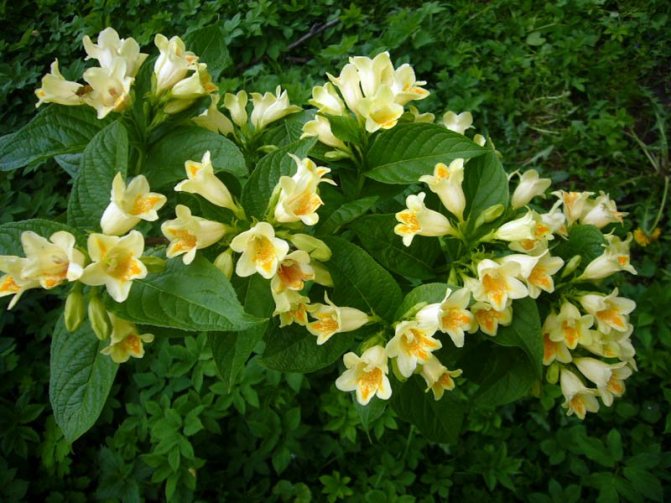

They consist of brushes on which up to 6 buds are attached. The flowering time lasts about 1 month. Flowers are yellow with orange splashes.
Weigela blooming
The first species that Europeans met was flowering weigela. It could be found in sufficient quantities in China and Korea. In foggy Albion, this shrub appeared thanks to the Scottish traveler and botanist R. Fortune, who brought it in 1845. When travelers later began to visit Japan, the variety of weigela increased in European countries.
Photo of weigela blooming
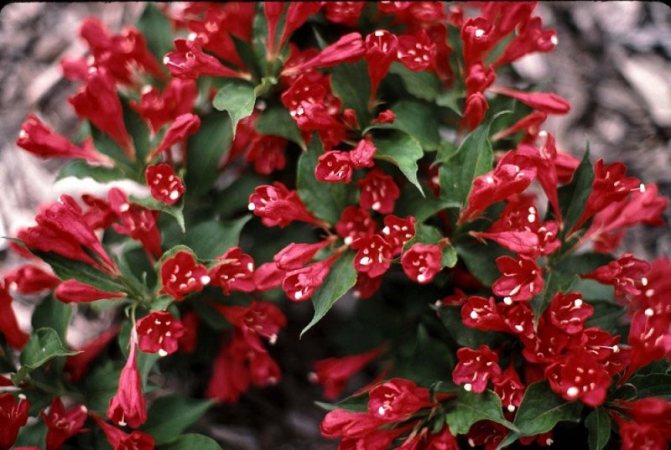

Weigela flowering is a tall, deciduous shrub that can reach 300 cm in height. The width can also be impressive, up to 350 cm in diameter.
Long shoots are bent to the ground under their weight, creating attractive pictures of arched branches. This species can be safely called the most frost-resistant, although in the northern regions it freezes underneath, if you do not take measures to shelter it.
Among the popular varieties of flowering weigela stand out
:
- "Carnival"
with extraordinary inflorescences, smoothly changing from pale pink to bright crimson tone;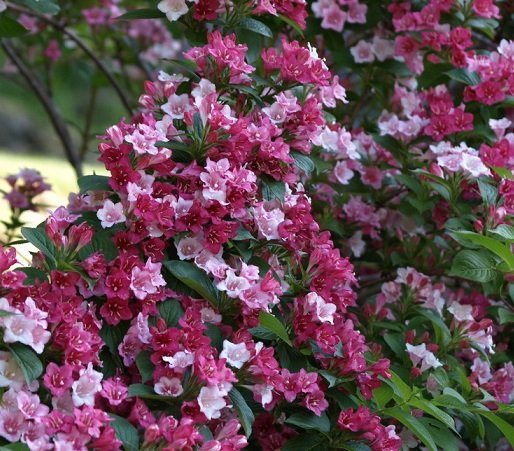

- "Nana variegata"
it is distinguished by a pale green tone of petals with a yellow border around the edges. The size of the bush is compact, not exceeding 150 cm in height.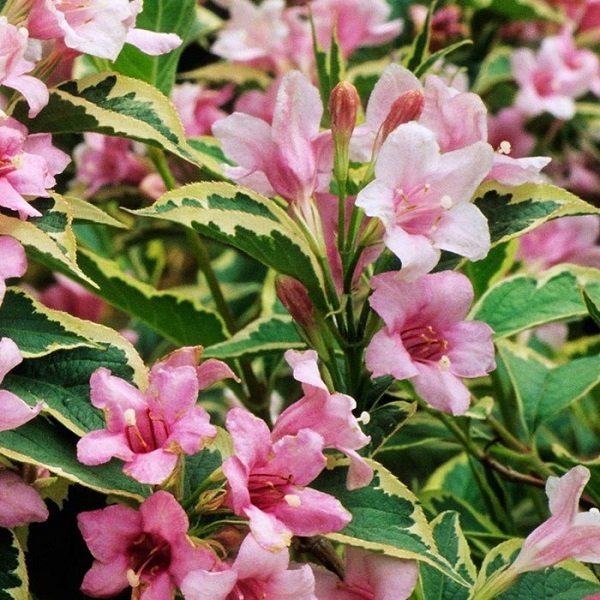

- "Alexandra"
in general, it looks spectacular due to the magenta color of the foliage and the bright colors of the petals.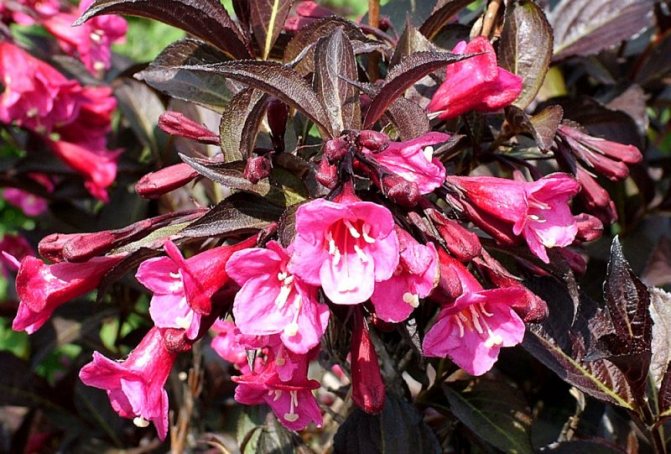

- Bristol Ruby
an attractive variety for those who dreamed of a bush with a rich red or pink color.
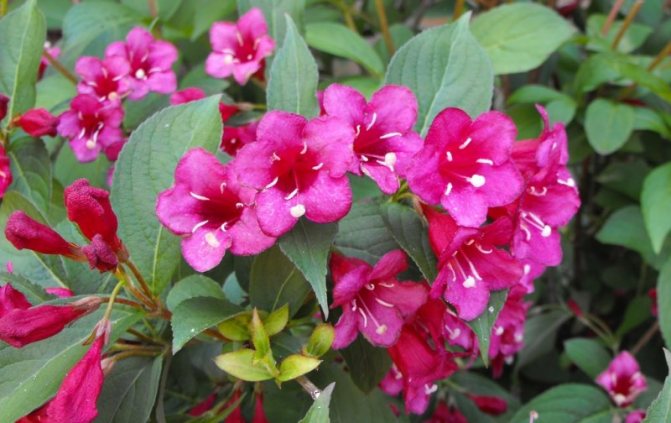

Weigela hybrid
This species appeared on the basis of flowering weigela.
Many hybrid products of breeding activities are hidden under the name. In the total mass, the varieties "Eva Ratke", "Candida", "Gustav Malle", "Styriake", "Newport Red", "Styriaka", "Pierre Duchartre", etc. are distinguished.
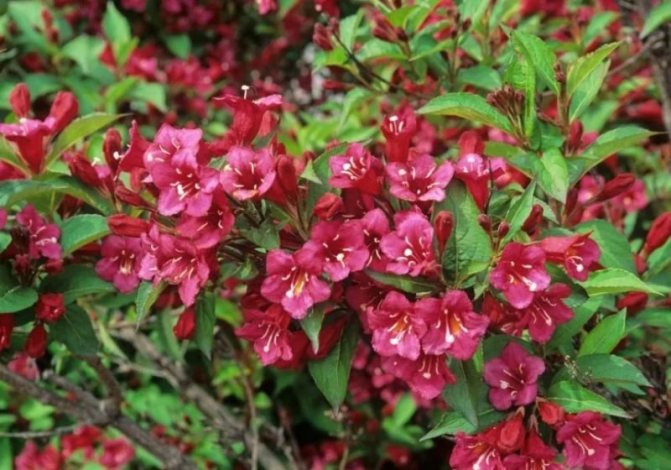

Vegela early
The rocky slopes of China, the Far East and Korea are considered the birthplace of the bush. Often used as a hedge. Shrubs of this species reach an average height of 150-200 cm. The inflorescences are drooping.
Photo of weigela early
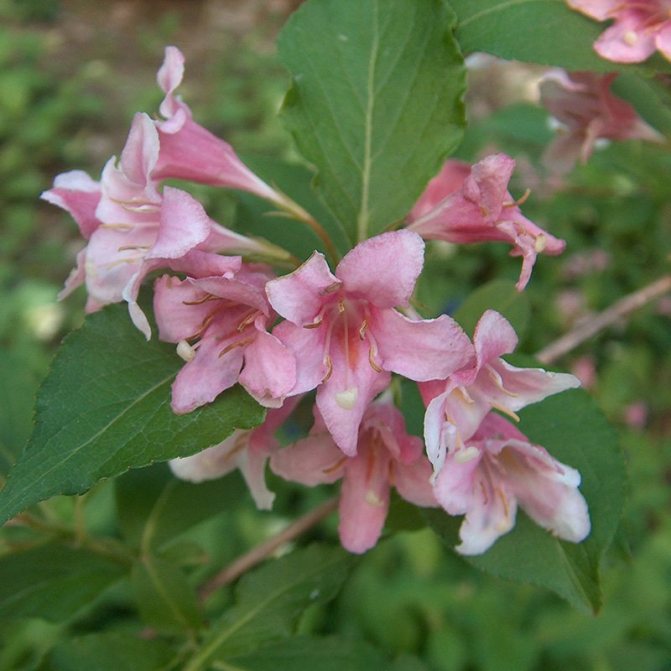

Flowers appear singly or in small inflorescences of 2-3 pcs. The buds are colored dark red, and as they open, they turn crimson. There are early varieties of weigela with white flowers. Flowering period May-June.
Weigela Korean
The Korean species of weigela is one of the tallest shrubs among its congeners. Adults reach 400-500 cm in height. Inflorescences are small in size, often painted in creamy pink and carmine colors.
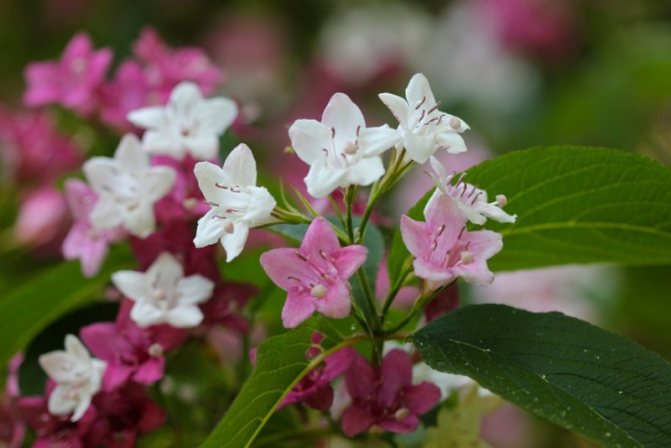

In the conditions of the Russian climate, the seeds of large 35 mm inflorescences do not have time to ripen. For the same reason, the foliage on the bush darkens, without falling off in the winter. Requires careful cover. Mostly found in the wild in Japan.
Japanese weigela
The shrub of this variety rarely exceeds 100 cm in height. Its foliage is oval in shape from 5 to 10 cm in length. Flowers create funnel-shaped bells no more than 3 cm in length. Three-flowered inflorescences are often carmine in color, slightly drooping in shape. Japanese weigela is prone to freezing, so it is worth taking measures to shelter it for the winter.
Weigela is nice
The pleasant weigela species is mostly common on the Kuril Islands, Primorye and Sakhalin.
Practically not grown in horticulture. The shrub prefers wildlife. Does not exceed a height of 130 cm. The foliage is bright green. The inflorescences are bell-like, colored pink inside the flower and purple outside. The size of the flower is small, 25-35 mm.
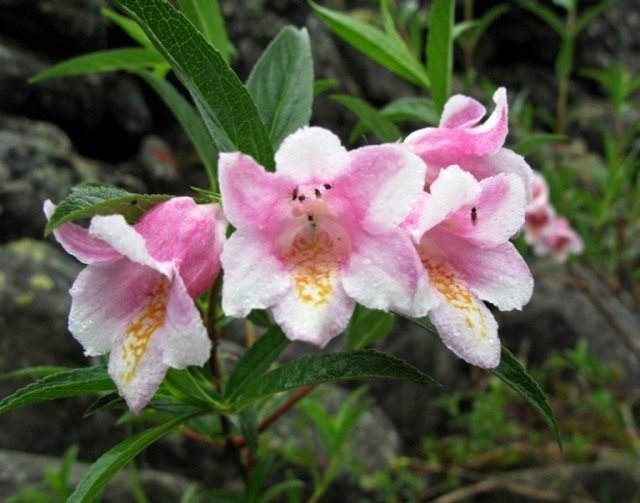

The weigela shrub blooms, pleasant twice a season: the first time in May, the second time at the end of summer. Partially winged seeds rarely ripen due to the peculiarities of the climate of central Russia.
Weigel Maksimovich
The birthplace of Weigela Maksimovich is Japan.
The shrub belongs to low crops. The foliage is 4-8 cm long, oblong-oval in shape. Inflorescences of a pale yellow color of about 35 mm, located on short shoots in twos.
Blooms in late May. Winged seeds ripen by mid-October.
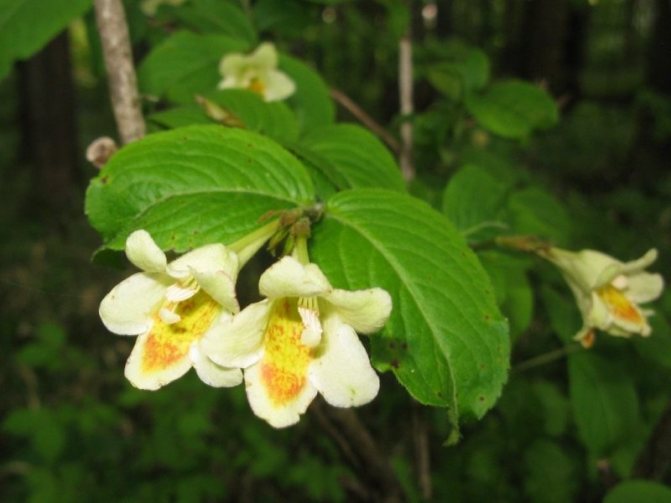

Where should weigela hybrid be
The first thing to do is to determine the place where such a plant will grow comfortably. It is also worth considering the quality of the land for planting.
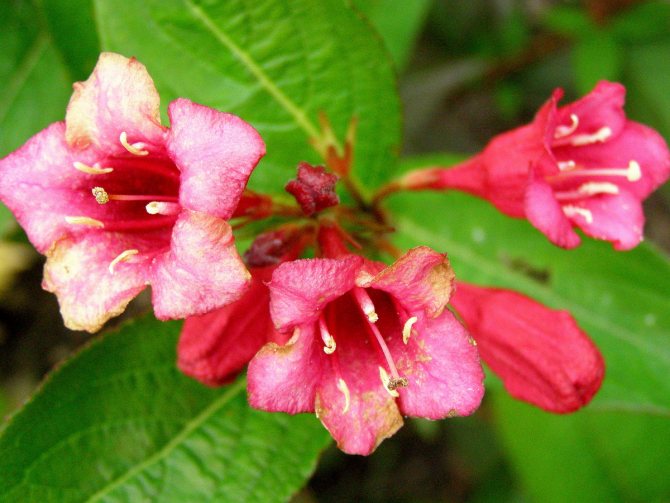

Places and soil that are optimal for the growth and development of the plant are:
- A shrub of this type prefers light areas that are located on hills. Also, such a site must be protected from strong winds. Large trees or various buildings can act as protection.
- As for the soil, such a shrub is a supporter of loose and fertile soils. But take into account that weigela has a negative attitude to waterlogging of the soil. For this reason, the planting of such a shrub should not be carried out in flooded places.
- Such a shrub also has a negative attitude towards acidic soils. So that the soil is not acidic, it is quenched with lime.
If you grow such a shrub in dark areas, then it begins to bloom much later. The flowering period is also reduced, or it may not start at all.
Weigela breeding methods
Weigela can be propagated in two ways - by seeds and cuttings.
Reproduction of weigela by seeds and cuttings - video
Propagation of weigela seeds
The seed method of reproduction of weigela will give a positive result, provided that you have high-quality seed.
They must be no older than 1 year. Sowing can be done directly into open ground in the fall.
Photo of weigela seeds
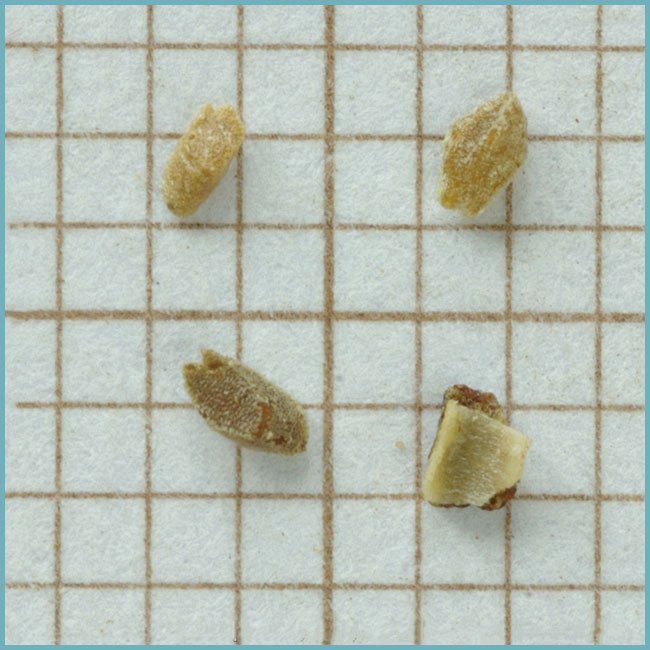

In the spring, seeds are sown in containers.
The soil is selected fertile and loose. After the appearance of the second leaf on the seedlings, they are dived into other containers. The next year, the plants grow up to 7 cm and grow 6-8 leaves. To prevent adjacent rhizomes from getting confused, seedlings are not planted too close to each other.
In the second year, weigela is planted in open ground in the spring.
For the winter, young plants must be covered from frost.
The shrub will delight with flowering only for 4 years of life. All types of weigel grow from the area of the root collar.
But since the seed method produces heterogeneous offspring, therefore valuable varieties are recommended to be propagated vegetatively.
Propagation of weigela by cuttings
Weigela, grown as a result of cuttings, blooms for 2 years of life.
For green cuttings, shoots are selected that are close to lining. They cut off the foliage or 1/3 of the leaf plate and immerse it in water for 120 minutes. After that, treatment in a growth stimulator for 12 hours is necessary. The drug Heteroauxin is often used.
Photo of weigela cuttings
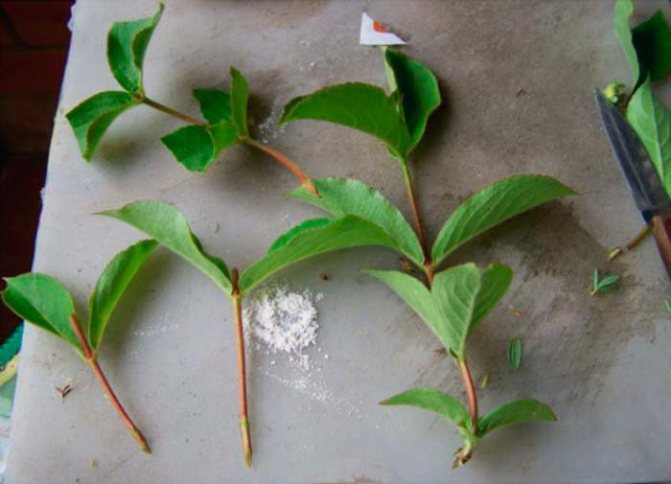

Green cuttings of weigela should be done in June.
At this time, the bush needs to be removed and protected from pests. Shaping pruning is done in July. At the same time, dry inflorescences are removed after flowering.
The green stalk is cut with a sharp knife into one internode. The cut should be straight. Cuttings are planted in a peat composition 1 cm deep. Cover from above with a transparent container (plastic or glass bottle). You need to moisturize every day. For the formation of a full and healthy crown, the first buds must be removed.
DECORATIVE VARIETIES OF PLANTS!
Honeysuckle HoneysuckleWisteriaClematis Manchurian small-flowered
Some propagate weigela using winter cuttings.
To do this, in April, cuttings are harvested from shoots on which leaves have not yet blossomed. The length of the planting material should be within 15-25 cm.
All cuttings are to be treated in a stimulating solution.
Why weigela does not bloom - video
Weigels are planted in a fertile mixture of peat and sand.
It must be admitted that winter cuttings root worse than summer ones. A month after rooting, the tops of the accepted shoots are pinched and fed with mullein or mineral complexes.
Useful article:
How to improve soil composition
Growing weigels from seeds
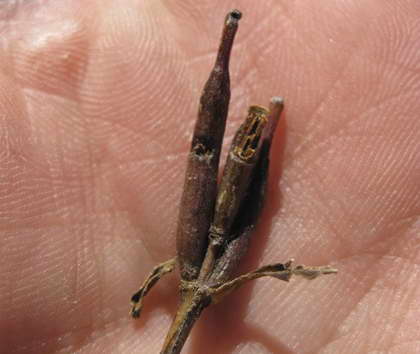

Weigela seeds photo
The plant is propagated by seeds and vegetatively.
Weigela seeds retain good germination for about 1 year. Stronger, more viable plants grow from seeds, but varietal characteristics are lost, so seed propagation is suitable for obtaining a large number of species of seedlings. There is no need to grow seedlings. You can sow before winter (November) or spring (end of April).
Sow winged seeds superficially, sprinkle with sand. For the winter, it is necessary to prepare a shelter, which should be removed in the spring. Seedlings appear in 3 weeks.
Weigela in landscape design
Such a flowering shrub like weigela can be used in landscape design in several ways - as a single planting and in the form of a hedge, and in a large company.
Moreover, dwarf varieties are more suitable for single plantings on lawns, next to other ornamental shrubs and on rocky slopes of stone gardens, and tall-growing species and varieties are appropriate along buildings, fences and in the form of hedges. In a group planting, one can consider the proximity of such plants - weigela, astilbe, hosta, fern, etc.
Photo of weigela options in landscape design
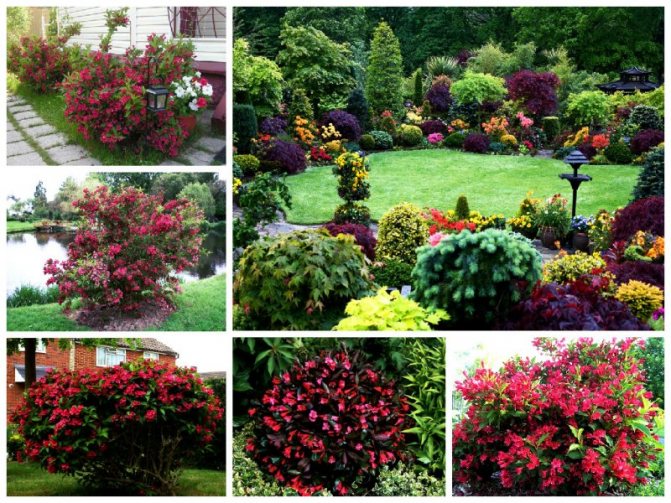

With mixed plantings, weigela is adjacent to spireas, forsythia, dwarf barberry shrubs, some conifers or undersized cypresses.
Preparing the weigela shrub for winter involves covering the near-stem space with soil.
The crown is wrapped with a non-woven fabric and tied with twine. If possible, the structure is fixed.
BEAUTIFUL FLOWERS!
HydrangeaGloxiniaMuscariCooper's variegated hibiscus
Weigela shrub photo
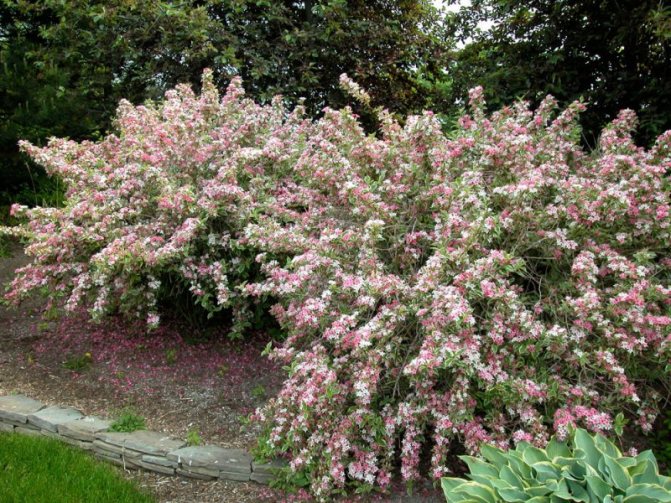

Choosing a seat for landing
A place for planting a plant such as weigela must meet the basic requirements:
- be located on a hill;
- not be exclusively in the shade, good illumination should always be (except at night);
- do not grow in the wind. With a strong wind, especially from the north, weigela flowers may fall off or not bloom at all.
- it is better to choose the south side of the garden plot;
- avoid rocky areas;
- the best option if the sun's rays fall in the morning or afternoon.
Special requirements are imposed on the soil itself, it must be:
- as loose as possible;
- rich in nutrients;
- with good moisture permeability;
- where the standing of flood water is excluded;
- with a neutral reaction.
Weigela diseases and pests
We can confidently say that the shrub is resistant to diseases,
but with waterlogged soil, it can suffer from gray rot, spotting and rust. Bordeaux mixture or Topsin will help in the fight against fungal diseases.
When attacked by insect pests such as aphids, spider mites, caterpillars and others, it is worth using "Karbofos", "Aktara", etc.


